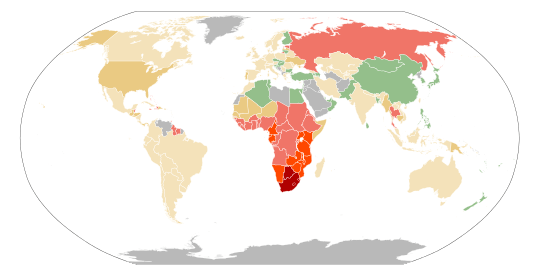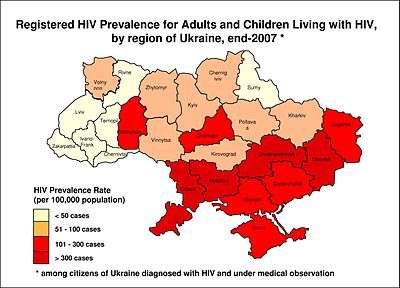HIV/AIDS in Europe

According to data from CIA World Factbook (2009), the countries with the highest prevalence of HIV/AIDS in Europe are Estonia (1.20% in people aged 15–49), Ukraine (1.10%), Russia (1.00%), Latvia (0.70%), Portugal (0.60%).[1]
In Western Europe, the routes of transmission of HIV are diverse, including paid sex, sex between men, intravenous drugs, mother to child transmission and heterosexual sex. However, many new infections in this region occur through contact with HIV-infected individuals from other regions. The adult (15–49) prevalence in this region is 0.3% with between 570,000 and 890,000 people currently living with HIV. Due to the availability of antiretroviral therapy, deaths from AIDS have stayed low since the introduction of protease inhibitors and combination therapy in the late 1990s. The Economist reported in January 2000 that almost 40% of "AIDS victims" are intravenous drug users.[2]
At the end of 2007, it was estimated that around 800,000 people were living with HIV in Western and Central Europe. This represents 8.1% increase over the estimated 740,000 in 2006. The highest rates were reported from Estonia, Portugal and Latvia; the lowest rates were reported by Slovakia, the Czech Republic and Romania. Although the numbers are relatively small when compared to the number of people living with HIV in areas such as Southeast Asia and sub-Saharan Africa, HIV/AIDS in Western and Central Europe is still considered a major public health issue.[3][4]
Regarding the social effects of the HIV/AIDS pandemic, there has been since the 1980s a "profound re-medicalization of sexuality".[5][6]
As part of the global AIDS pandemic, there is also growing concern about a rapidly growing epidemic in Eastern Europe, particularly in Estonia and Russia, and Central Asia.
Albania
Albania remains to have a low number of HIV death-related cases. Between 1992 and until the end of 2011, Albania reported a total of 487 HIV cases. Among these 487 cases: 83.1% heterosexual contact, 12.7% were transmitted through sexual contact between men, and 4.2% were transmitted from mother to child. No HIV cases were transmitted through injecting drug use.
In the year 2011, Albania had a total 71 new HIV infections, 38 AIDS cases, and 9 AIDS-related deaths. Of the newly reported HIV cases, 73% were male.
However, Albania remains to have a low HIV testing coverage for its general public. Only 2% of clinics and health facilities in Albania offered HIV testing services. Within those who acquired testing, 48% were men who were in sexual contact with another man.
Belgium
Belgium had a total of 24,506 HIV cases by the end of 2011. Out of the total, 4,181 developed AIDS. For the year of 2011 alone, there were 1,177 new HIV cases, 54 new AIDS cases, and 30 HIV-related deaths found. Most of the newly diagnosed cases were transmitted through heterosexual contact, 49.6%. Secondly, HIV cases transmitted through sexual contact among men were at 46.6%. Third, 1.3% of HIV cases were transmitted through injected drug use. And 1.0% of HIV cases were transmitted from mother to child.
Unlike other countries in Europe, Belgium offers HIV testing by all practitioners, clinics, hospitals, and student services. A few sites offer them with any costs.
Not taking into account the people who are not aware of their infection, there is an estimated 20,000 people who are infected.
Czech Republic
In the Czech Republic on 31 December 2015 diagnosed 2,620 HIV-positive people, 3,024 people including foreigners (404 people = 12,7%). In 2015, it increased 266 (248 males, 18 females). From January to September 2016 was diagnosed in 244 people (for a total of 30 September 2016 to 2,864 persons). Most affected is the city of Prague (1394). Since 1994 the Czech Republic had made 25.3 million HIV tests. Examinations at his own request counts 364,296 people. 65% of people with HIV in testing indicated that the reason for the test is gay / bisexual sex. AIDS outbreak at 458 people (as of 31 December 2015. The statistics led from 1 October 1985), of which 339 of them died. The average age diagnosed is 35 years for men and 39 years for women. In 2016, continuing the growth trend in newly diagnosed persons. It is expected to record growth again. But the Czech Republic is still among the least affected states. [7]
Estonia
As of 2013 estimates for Estonia are 7,200 to 11,000 people infected with HIV.[8]
Russia
By 2004 the number of reported cases in Russia was over 257,000, according to the World Health Organization, up from 15,000 in 1995 and 190,000 in 2002; some estimates claim the real number is up to five times higher, over 1 million. There are predictions that the infection rate in Russia will continue to rise quickly, since prevention measures may not be sufficient.
Ukraine

Ukraine has growing numbers of infected people, with estimates of 500,000 in 2005. The epidemic is still in its early stages in this region, which means that prevention strategies may be able to halt and reverse this epidemic. However, transmission of HIV is increasing through sexual contact and drug use among the young (under 30-year-olds). Indeed, over 80% of current infections occur in this region in people less than 30 years of age.
See also
- Epidemiology of HIV/AIDS
- HIV/AIDS in Africa
- HIV/AIDS in Asia
- HIV/AIDS in North America
- HIV/AIDS in South America
- International Stele Always Remember, Berlin, Germany
References
- ↑
 This article incorporates public domain material from the CIA World Factbook document "Country Comparison :: HIV/AIDS - Adult Prevalence Rate".
This article incorporates public domain material from the CIA World Factbook document "Country Comparison :: HIV/AIDS - Adult Prevalence Rate". - ↑ "Going Dutch?". The Economist. 13 January 2000. Retrieved 11 October 2011.
- ↑ "Euro report on HIV" (PDF). 2009.
- ↑ "HIV & AIDS in Western Europe". TheBody.com.
- ↑ Aggleton, Peter; Parker, Richard Bordeaux; Barbosa, Regina Maria (2000). Framing the sexual subject: the politics of gender, sexuality, and power. Berkeley: University of California Press. p. 3. ISBN 0-520-21838-8.
- ↑ Carole S. Vance (1991). "Anthropology Rediscovers Sexuality: A Theoretical Comment". Social Science and Medicine. 33 (8): 875–884. PMID 1745914.
- ↑ {{cite web|url=http://www.szu.cz/uploads/documents/CeM/HIV_AIDS/rocni_zpravy/2015/Tiskova_zprava_NRL_pro_HIV_AIDS_v_CR_v_roce_2015.pdf}|title= Tisková zpráva NRL pro HIV/AIDS v ČR v roce 2015}
- ↑ "Know your epidemic". UNAIDS. Retrieved 6 March 2014.
External links
- World Health Organization: Regional office for Europe
- AIDS epidemic update 2005 (PDF)
- Specific country data from UNAIDS
- AIDSPortal Eastern Europe page (the UK) - latest research, case studies and news stories
- AIDSPortal Western Europe page (Albania, Armenia, Azerbaijan, Russia and Ukraine) - latest research, case studies and news stories